|
Queen Elizabeth National Park, Uganda July 2000 |
||
| (Click any photo throughout to see a larger version) | ||
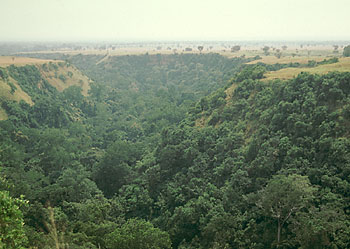
|
||
| Chambura Gorge | ||
|
Queen Elizabeth National Park is a large park with a broad
range of scenery and habitats. However, the overall population of large
mammals is much lower than it has historically been, having been ravaged
during the infamous reign of Idi Amin starting in the mid-1970s. Still,
we found it to be jaw-droppingly beautiful, and we thoroughly enjoyed
our visit.
Pictured above is Chambura Gorge, at one edge of the park. A river cuts a deep fissure through the savannah, and the fissure is filled with thick tropical vegetation. We spent a morning hiking in Chambura Gorge hoping to see the habituated chimpanzees that live there. But the chimpanzees did not cooperate and we had to settle for scenic beauty, colobus monkeys, and a frog or two. | ||
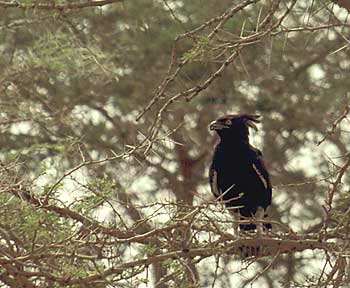
|
||
| Snacking eagle | ||
| We saw many a fine bird in Queen Elizabeth National Park. One of the first big dramatic raptors we came across was this long-crested eagle (Lophaetus occipitalis). You can't tell from this photo, but it was snacking on what our guide Gabriel tentatively identified as a juvenile yellow-necked spur fowl (Francolinus leucoscepus). This type of eagle turned out to be relatively common, as we saw several more on our trip. | ||
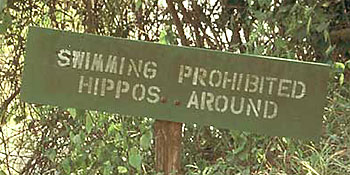
|
||
| But ... hippos are so cute! | ||
| You've probably heard from some authority or another that hippos kill more people in Africa than any other animal. We heard that a few times on this trip too. But my sister, who is very partial to hippos, insists that their violent reputation is undeserved, or at least exaggerated. For one thing, a lot of those people they're credited with killing actually drowned when playful hippos overturned their boats. You can hardly blame the hippos for that, right? And let's not forget the lowly mosquito, whose human-killing toll dwarfs that of the hippo. Still, all in all, cute and playful as they may be, it's better not to go swimming when there are hippos around, so we heeded this sign. | ||
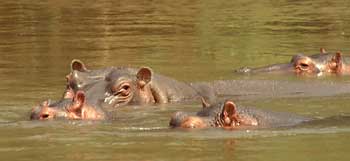
|
||
| Our first hippos | ||
| We ate lunch at a campsite right on the bank of the Ishasha river, which at this point separates Uganda from the Democratic Republic of Congo. A group of cuddly hippos frolicked nearby in the river. We asked Gabriel what kept the hippos from coming into the campsite at night and stomping all the people. He said that if you keep a fire going then the hippos won't come stomp you. You should remember this for the next time you're camping overnight in the open air near hippos. | ||
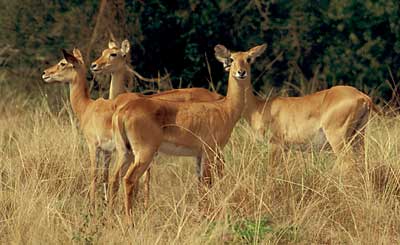
|
||
| Push-Me Pull-You attached at the head? | ||
| We discovered that antelope in African national parks are indeed about as plentiful as you would expect from watching television. In Queen Elizabeth National Park, kob like these were the most easily seen mammals. | ||
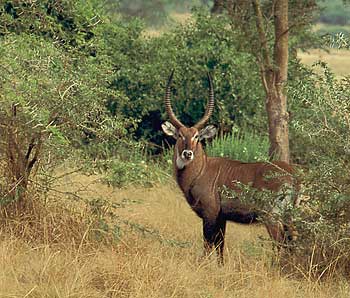
|
||
| Waterbuck | ||
| Many a waterbuck like this one also made its presence known. We learned that the sure-fire way to tell waterbuck from other similar antelopes is to check for the white rear end (called the "toilet paper ring" by our Kenyan guide Albanus). This only works, of course, when they're moving away from you, but that's usually the case. On safari, you definitely get more good looks at animals' rear ends than at their faces. | ||
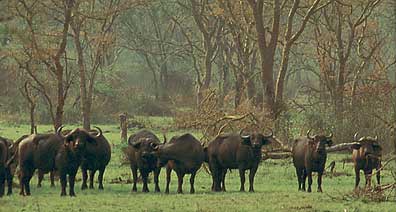
|
||
| Don't mess with us | ||
| Cape buffalo often stopped and stared malevolently when we drove near. We felt plenty safe in our vehicle, but were reminded repeatedly how easily and with apparent pleasure buffalo kill people who are on foot. Clearly they are far meaner than hippos, and deserve a worse reputation. | ||
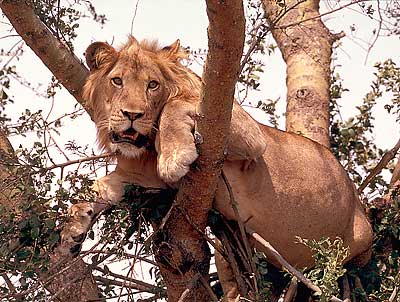
|
||
| I can't believe I ate the whole thing | ||
| Lions typically spend most of their time on the ground, but in the Ishasha area of Queen Elizabeth National Park they are often found lounging in trees. Gabriel told us that they apparently climb the trees to avoid the nasty biting low-altitude-maintaining flies. "King of the Beasts" indeed! We found a pair of youngish males in one tree, and a pair of females in another tree nearby. This male in particular looked well-fed and content with life. | ||
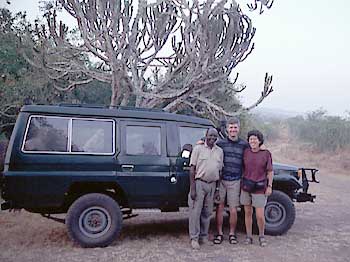
|
||
| Gabriel and us | ||
| Our last morning in Uganda we posed for this obligatory group photo with our guide and safari vehicle. Gabriel was a wonderful, knowledgeable companion and we wish him the best. | ||
Onward to Tsavo West | ||
| Return to Uganda and Kenya Trip Overview | ||